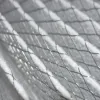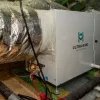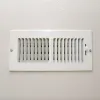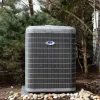You’ve probably seen flexible air ducts (aka flex ducts) in your attic or crawlspace. They look like this:
Yep, flex duct is that weird foil piping that looks like it was made for NASA or something. It’s just a tube that air moves through. Or as is the case in many homes, struggles to move through.
You see, flex duct is rarely installed very well. If you’ve ever seen a kinked or sagging flex duct and wondered whether that was a problem, you were onto something! Since the flex duct, by definition, is flexible, it often flexes in ways we don’t want it to.
The result is poor airflow and ineffective HVAC systems.
We like flex duct. But you have to install it properly.
That’s the thing about flex ducts. When HVAC contractors use it the way it’s intended to be used, it’s fine. However, in many homes, flex duct is overused because it’s relatively easy to install compared to hard pipe duct.
In addition to being overused, it’s frequently installed sloppily. Over time, it sags or gets bent and inhibits precious airflow through your system.
This doesn’t have to happen. HVAC installers can use a flex duct and avoid these problems. They just need to install it the right way.
Speaking of the following steps cover the right approach to take when installing flex duct:
1. Remember: A good duct system will rarely be all flex
This is key. We’re about to cover where and how you can deploy flex ducts, but you’ve got to keep in mind that a good duct system will not only use flex ducts.
You’re going to have to install hard pipe material as well. Hard pipe, of course, will not kink or sag. It’s also way less susceptible to damage. Something could fall on your flex ducts and dislodge or tear them. Hard pipe? Not so much.
With smaller duct systems, it might be ok to use almost all flex, but the elbows and bends should still be a hard pipe. In any case, just remember that there are very few situations where an all-flex duct system is ok.
2. Do everything else right before installing anything
You don’t get to install flex duct if you haven’t performed a Manual J load calculation, a Manual D for duct design, and Manual T for determining the register and grille sizes. After going through these exercises, then you can decide whether it’s ok to use a flex duct.
And after doing all of those things, you might still decide not to use a flex duct. It all depends on the results.
Doing all of this legwork is like doing your homework. Climbing into an attic with a bunch of flex ducts if you haven’t done this stuff first? That’s the equivalent of skipping class for the entire semester and then showing up on the day of the final exam. It’s not smart.
In most cases, these exercises will show you that it is possible to use a flex duct in certain places. But where?
3. Use flex duct for straight runs
You’ll know you can use a flex duct if your design contains straight runs (i.e. long, straight sections of the duct). Since flex duct typically underperforms due to sagging and kinking, straight runs pretty much eliminate this.
Yes, the duct can still sag on a straight run. But it won’t sag if your contractor supports it properly.
Anything any duct sections that aren’t straight? Use hard pipe! This includes bends, elbows, and anything that’s coming right off the plenum. A bent flex duct will not allow air to flow properly, but a hard pipe duct will.
The only time it might be ok to use a flex duct for a bend is on a very long one with a big radius. But even then, the hard pipe is probably better.
4. Pull it tight and keep it straight
If your contractor uses a flex duct for straight runs, they must pull it tight when they install it. Otherwise, the inside of the duct will be kind of bumpy and compressed. Air won’t flow through it properly, and it will be more subject to sagging over time.
5. Test and balance
Did your contractor do a good job when they installed the flex duct? They’ll know if they test their work.
After installing any ductwork, flex or otherwise, it’s important to check the static pressure and airflow through the system. Your HVAC contractor has the equipment to perform these measurements. If your system isn’t moving the right amount of air (which it should be because it was properly sized and designed, remember?), the contractor will need to go back and make adjustments until it’s right.
Flex duct, in particular, also needs really good quality control. It’s just so easy to bend or crush it! That’s why we’re big believers in rigorous focus and precision during a flex duct installation as well as a post-installation audit, preferably from a senior team member.
It’s ok to be a flex duct user. Just use it in moderation.
Using a flex duct for straight runs is usually fine, especially if you’re doing it as part of a deliberate and meticulous custom ductwork design for a home.
But using it because it’s easy to install? Or using it for bends? That’s just irresponsible.
When we install ductwork, we usually use a combination of flex and hard pipe ducts. In most homes, most of the time, that will work. But only if you do your homework first and make sure you’re delivering a quality duct design with materials and installation quality that lasts.
That’s the right way to install flex ducts or, for that matter, any kind of ducts. It’s difficult to do it right, but it’s worth it.






